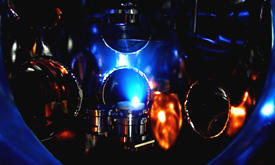

05/25/2015

© 2015 Susumu Shiraki
Lithium-ion batteries are the clear leaders in the rechargeable battery market, being used to power everything from mobile phones to Mars rovers. Since batteries with liquid electrolytes can suffer from leakage or explosions, there has been a concerted effort to improve the safety of lithium-ion batteries by using solid electrolytes, but often at the expense of battery performance. Now, researchers from the AIMR at Tohoku University have produced lithium-based solid interfaces that have very low resistances and thus promise to deliver both safety and excellent performance for high-energy-density applications1.
For a battery to achieve high energy densities, all of its components must have high ionic conductivities. However, in batteries with solid electrolytes, the formation of negative space-charge layers at electrode–electrolyte interfaces gives rise to a poor ionic conductivity. “The major drawback of all-solid-state batteries is the low ionic conductivity at electrode–electrolyte interfaces,” explains Susumu Shiraki, one of the researchers involved in the study.
Most solid electrolytes are powder based, which results in ill-defined interfaces. To overcome this problem, Shiraki and his colleagues produced electrolytes by growing high-quality thin films with sharp, well-defined interfaces.
“Many researchers face difficulties in fabricating all-solid-state thin-film batteries, which mainly stem from internal short circuits between the cathode and anode and from the weak adhesion and high interface resistivity between stacked films,” notes Shiraki.
The researchers avoided these difficulties by drawing on their extensive experience in growing high-quality thin films. They used magnetron sputtering in a vacuum to grow 100-nanometer-thick films of lithium phosphorus oxynitride directly on electrodes of lithium cobalt oxide.
The interface boasted a remarkably low resistance — one that was over ten times smaller than those reported for other all-solid-state batteries and even lower than those of batteries with liquid electrolytes. The result indicates that this electrode–electrolyte combination has a negligible negative space-charge layer at the interfaces.
Shiraki attributes his team’s success to stringent quality control during fabrication: “The keys to obtaining a low interface resistance are minimizing sputtering damage when depositing electrolyte films and avoiding contamination at the interfaces.”
“Our findings suggest that it is possible to develop bulk-type all-solid-state batteries with a low interface resistance by preparing clean electrode–electrolyte interfaces,” says Shiraki, noting that this will require making the process compatible with industrial fabrication conditions.
The team intends to investigate other electrode–electrolyte combinations. For example, “we plan to employ crystalline electrolytes to fabricate all-solid-state batteries by stacking epitaxial films of cathode, anode and electrolytes,” says Shiraki.
Haruta, M., Shiraki, S., Suzuki, T., Kumatani, A., Ohsawa, T., Takagi, Y., Shimizu, R. & Hitosugi, T. Negligible “negative space-charge layer effects” at oxide-electrolyte/electrode interfaces of thin-film batteries. Nano Letters 15, 1498–1502 (2015) | article
This research highlight has been approved by the authors of the original article and all information and data contained within has been provided by said authors.